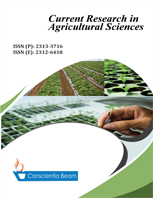On-Farm Evaluation of Conservation Agriculture Practice on Weed Control and Yield of Wheat in Northern Bangladesh
DOI:
https://doi.org/10.18488/journal.68.2020.72.84.99Abstract
On account of rural labour shortages, smallholder farms in South Asia are seeking labour saving strategies for planting and weed control. To overcome this challenge, conservation agriculture practices involving mechanized planting and crop residue retention together with the application of herbicides are being developed. But their effectiveness for weed control is still uncertain. The present study was undertaken to determine the effectiveness of residue retention relative to herbicides and hand weeding for weed control and yield of wheat in strip planted soil in northern Bangladesh. The on-farm experiment was conducted during November-March in 2014-2016, with wheat cv. BARI Wheat 26 grown after monsoon rice under two tillage types combined with the six weed control practices [P1: conventional tillage (CT)+three hand weedings (HW) (Control), P2: Glyphosate (Gly)+strip planting (SP)+one HW, P3: Gly+SP+pre-emergence (PE) herbicide, P4: Gly+SP+post-emergence (PO) herbicide, P5: Gly+SP+PE+PO, P6: Gly+SP+weed-free (WF); and two levels of rice residue retention, R0: no-residue and R50: 50% residue (by height). The CT consisted of two primary tillage operations by a two-wheel tractor, anwhiled SP had done by a Versatile Multi-crop Planter in a single-pass process. A pre-plant herbicide (glyphosate), a PE herbicide (pendimethalin) and PO herbicide (carfentrazon-ethyl) was applied at recommended doses. The combination of applied glyphosate, SP, followed by sequential application of PE and PO herbicides and the retention of 50% of rice straw achieved the highest weed control efficacy. Furthermore, this practice produced the 24% higher yield and 40% higher economic returns relative to control without exerting any phyto-toxicity in wheat.

